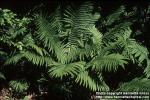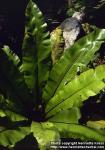 Preparation: Oleoresin of Aspidium
Preparation: Oleoresin of Aspidium
Related entry: Pteris
"The rhizome of Dryopteris Filix-mas, Schott. and of Dryopteris marginalis, Asa Gray"—(U. S. P.). The first is the Aspidium Filix-mas of Swartz and others, and the Polypodium Filix-mas of Linné. It has many other synonyms. The second is the Aspidium marginale of Willdenow.
Nat. Ord.—Filices.
COMMON NAMES: (1) Male-fern, (2) Marginal shield-fern.
ILLUSTRATIONS: Bentley and Trimen, Med. Plants, 300; Woodville's Med, Bot., Pl. 271; Johnson's Med. Bot. of N. A., Fig. 160 and Pl. ix.
Botanical Source.—Male-fern (Dryopteris Filix-mas) has a large, perennial, tufted, scaly rhizome, sending forth yearly several leaves, 3 or 4 feet high, erect, disposed in a circle, oval, lanceolate, acute, pinnate, bright-green, and leafy nearly to the bottom; their stalks and midribs having tough, brown, transparent scales throughout; divisions alternate, taper-pointed, and pinnate; the pinnae or leaflets numerous, crowded, sessile, for the most part distinct, occasionally somewhat combined at the base, oblong, obtuse, crenate throughout, the lateral notches broadest and most shallow, the terminal ones more crowded and acute, without any terminal bristles; both sides smooth, destitute of glandular globules, but having a depression on the upper one over the insertion of each sorus. The sori are circular, tawny, arranged in simple, close, short rows, near the partial midrib, scarcely occupying more than the lower half of each leaflet. The indusium is circular, durable, crenate, and tumid, with a cleft terminating in the central depression. The thecae are numerous, shining-brown, and prominent all round for a little beyond the indusium (W.—L.).
Dryopteris marginale differs from the preceding mainly in having its fruit dots or sori arranged upon the margins of the fronds, the latter being from 1 to 2 feet in length, of an ovate-oblong shape, and light-green color. The pinnae are lance-shaped, with an almost sessile, broad base; the pinnules are crowded, and are oblong in outline, with an obtuse termination.
History and Description.—Male-fern is found growing in many parts of Europe, and likewise in various sections of the United States. It is also found in South America, Africa, Asia, from the Himalayas northward, and in the islands of Polynesia. The dried root or rhizome is the official part, which, divested of its leaf-stalks and radicles, is from 8 to 12 inches in length and 1 or 2 inches thick, compressed, tortuous, tuberculous, brown or dark-brown epidermis, yellowish, rarely reddish parenchyma, fragile, striated, almost inodorous, with a nauseous sweet taste, but at last becoming rancid, slightly astringent and bitter. The fibrous radicles are covered with brown, paleaceous scales (Ed.). The U. S. P. thus describes the official drug: "From 5 to 15 Cm. (2 to 6 inches) long, 10 to 25 Mm. (½ to 1 inch) in thickness, and, together with the closely imbricated, dark-brown, roundish, and slightly curved stipe-remnants, 50 to 75 Mm. (2 to 3 inches) in diameter; densely covered with brown, gloss transparent, and soft, chaffy scales; internally pale green, rather spongy; vascular bundles about 10 (Dryopteris Filix-mas) or 6 (Dryopteris marginalis) in number, arranged in an interrupted circle; odor slight, but disagreeable; taste sweetish, acrid, somewhat bitter, astringent, and nauseous. The chaff, together with the dead portions of the rhizome and stipes, should be removed, and only such portions as have retained their green color should be used"—(U. S. P.). The fresh root is colored bluish-black by iodine, which is indicative of the presence of starch. From the first of June to the latter part of September is the proper time for collecting it—when it should be cleansed without being washed, then dried quickly in the shade and open air without heat. Select those parts which are greenish internally, immediately pulverize them, and keep in well-closed bottles. The powder is pale greenish-yellow and has a peculiar earthy, disagreeable odor, and the same taste as the crude root (C.). In two years the best article becomes useless.
Chemical Composition.—According to Geiger male-fern contains green fat oil (composed, according to Luck, of glycerides of filosmylic and filixolic acids), green resin, uncrystallizable sugar, easily oxidizable tannic acid, gum, salts, starch, and lignin. In addition to these Bock found fixed and volatile oil, pectin, albumen, etc. According to Peschier, the fern-buds contain a volatile oil, brown resin, fat oil, solid fatty matter, green coloring principle, a reddish-brown principle, and extractive. Three acids have been found by Dr. C. Luck in the root; two from the root itself, named "tannaspidic" and "pteritannic acids" (soluble in ether), and one from its oil, termed "filicic acid." The latter has the formula, C14H18O5.according to Grabowski (1867) or C13H14O4 (Luck) or C14H16O5.(Daccomo, 1889). The first-named regards it as dibutyryl-phloroglucin, for at near the fusing point of potassium hydroxide the latter decomposes it into butyric acid and phloroglucin. An impure filicic acid constituted Pavesi's (1861) aspidin. Malin (1867) isolated but one tannin, and to it he gave the name filitannic acid. Protecatechuic acid and phloroglucin result when this acid is fused with caustic potash; and when boiled with diluted mineral acids it yields glucose and filix-red (impure tannaspidic acid of Luck). Daccomo (Amer. Jour. Pharm., 1889) found a white wax-like body, having the composition (C13H26O)n., filicic acid, tannin, glucose, filix-red, a green oil, a brick-red, and a black, plastic resin.
Marginal shield fern yields filicic acid and a tannin probably identical with that of male-fern (Patterson, 1875).
The oil may be obtained by digesting the powdered root in pure ether, filtering, and then distilling or evaporating the ether from the ethereal tincture. It is a thick black oil, having the taste and odor of the root, reddening vegetable blues, depositing stearin when left at rest, and yielding a little volatile oil when distilled from water. Alcohol partially dissolves it; it burns with a thick smoke, and is composed, according to Peschier, of fat, resin, volatile oil, coloring matter, extractive, chloride of potassium and acetic acid.
Action, Medical Uses, and Dosage.—Aspidium was the secret taenicide of Madame Nouffer, and was purchased of her by the French King in 1775. The oleoresin has been shown to be poisonous, five fatal cases out of twenty being recorded (Katayama and Okamoto, 1892). Vomiting, purging, headache, dizziness, dyspnoea, cold perspiration, cyanosis, disordered intellect, profound stupor, and convulsions are among its effects. In some cases amblyopia and permanent amaurosis have occurred, though the vision is generally restored.
Male-fern is used for the expulsion of the tapeworm. Bremser says it is an excellent remedy against the Bothriocephalus latus, but it is not so efficient against the Taenia solium, and Merat entertained a similar opinion. According to Peschier the best mode of administration is the ethereal oil or extract, of which 18 grains, or from 10 to 25 drops, may be given in the form of pill or emulsion at night and again in the morning; 2 hours after the administration of the last dose a purgative dose of castor oil is to be taken, and the worm is discharged dead, without any severe or unpleasant symptoms. Dose of the powder, 1 to 4 drachms; of the ethereal tincture of the buds, which is made by digesting 1 part of the buds in 8 parts of ether, 8 to 30 drops (see also Oleoresina Aspidii).
Related Species.—Polypodium incanum, Pursh. Said to be employed by Alabama negresses to prevent conception. It is a popular Southern remedy for dysmenorrhoea. Emmenagogue.
Aspidium rigidum, Swartz. Europe and Pacific coast range. Contains same constituents as Filix-mas, and in California is used like it as a popular taenicide.
 < Asplenium Filix-faemina, Bernhardt. Reputed taenicide.
< Asplenium Filix-faemina, Bernhardt. Reputed taenicide.
The rhizome of Asplenium thelypteroides, Michaux. North America. Resembles the preceding.
Aspidium Athamanicum, Kunze. South Africa. The inkomankomo (uncomocomo) of the Kaffirs and pannum (Rhizoma Pannae) of commerce. Taenifuge. Contains pannic acid, a principle closely related to filicic acid (see Kürsten in A. P. A. Proceedings, 1892, p. 605).
Scolopendrium officinarum, Smith (Asplenium Scolopendrium, Linné). Hart's-tongue. A fern indigenous to Europe and America, whose leaves have a sweetish, mucilaginous, subastringent taste. An unpleasant oleaginous odor is emitted if the leaves be rubbed. They have been variously employed as a demulcent in disorders of the respiratory tract, as a deobstruent in affections of the abdominal contents, and as an astringent in excessive discharges and hemorrhages.

